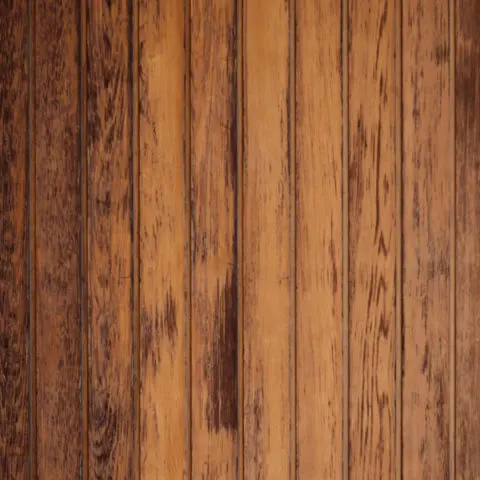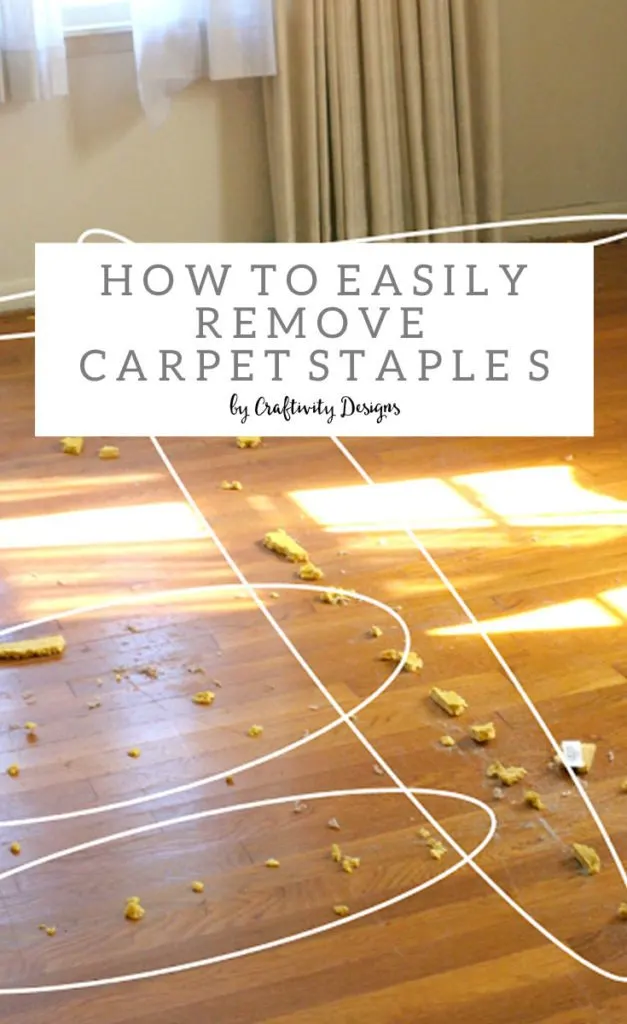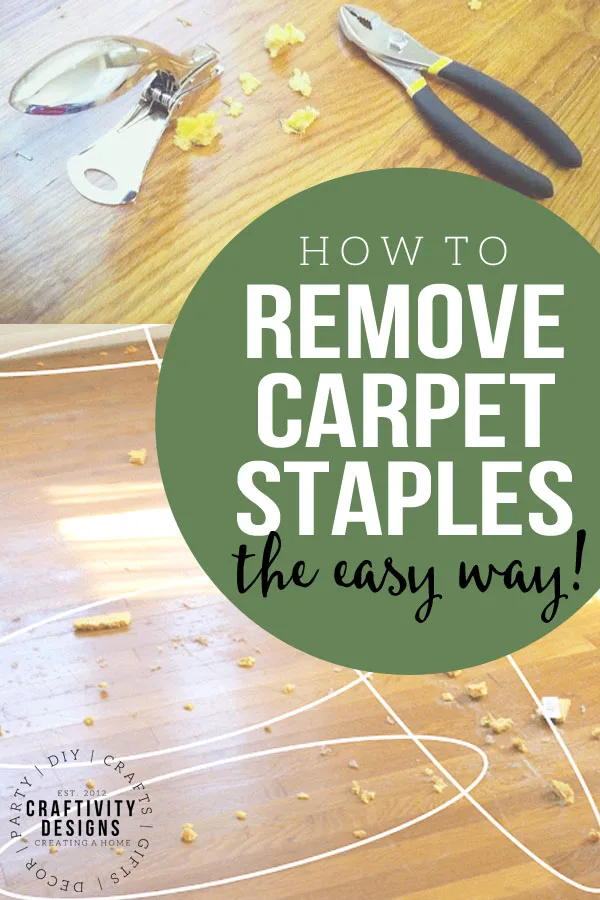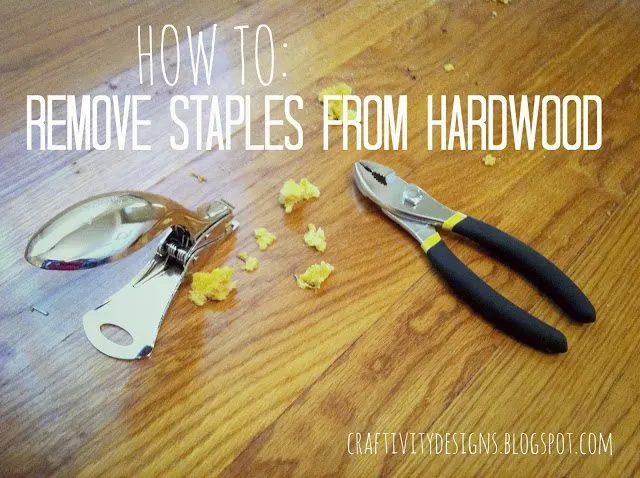Learn the simplest method to remove carpet staples from wood floors, with the right tools and a video tutorial. Plus, this method won’t damage the hardwood!
There is no happier reno surprise than pulling up a corner of wall-to-wall carpeting and finding hardwood. Am I right?! Original hardwood hidden under ugly, old carpet can save big bucks on flooring. However, for the DIYer, it won’t save you tons of time. Most likely, you’ll be spending hours on hands and knees, plucking out tiny carpet staples.
That was the case in a 1950s ranch home we renovated. Nearly 1100 Sq Ft of hardwood had been covered by carpet for decades — and full of staples. It appeared that carpet may have been laid several times because some of the staples were older/rustier/more fragile than the rest.
How do I remove carpet staples from hardwood floors?
There are a couple of ways to remove carpet staples from hardwood floors: the traditional method and the easy way. How do I know? We’ve removed the carpet in 3 homes (soon to be 4…) and through trial and error, we’ve learned what works.
The Traditional Method
The traditional method utilizes a combination of basic tools:
- flathead screwdriver
- pliers
- 6-in-1 painter’s tool
How does it work?
- Slide the flathead screwdriver or the 6-in-1 painter’s tool under each carpet staple in order to lift it up from the wood floor.
- Once the staple is lifted away from the floor, use the pliers to pull the staple fully out of the wood.
Sounds simple enough, right? So, what are the pros and cons of the traditional method?
Pros
- The traditional method does work. It’s an effective way to tackle this daunting DIY job.
- Since the required tools are basic, you most likely already have them in your toolbox.
Cons
- The traditional method is slow and tedious work. Though some carpet staples will pop up easily, many require twisting and pulling with the pliers.
- This method is tough on your hands (expect sore wrists and blisters on your fingers).
- Lastly, the traditional method can damage hardwood. How? Wedging the flathead or painter’s tool under a staple and angling it up can scrape the wood finish.
We used the traditional method in our first home. It had plywood (not hardwood) under the carpet. Therefore, we weren’t worried about damaging the finish. Still, it was tedious.
In the second home that we renovated, we were faced with the task of removing so. many. staples. Plus, that hardwood finish was too pretty to damage.
The slow work of using a flathead screwdriver to lift each staple motivated us to purchase this tool from Amazon… aka: the easy way to remove carpet staples from hardwood.
Tools to Remove Carpet Staples from Hardwood
The Easy Way
There was a product review that described using an office-style staple remover for hardwood floors and carpet staples. For the affordable price tag, we felt like it was worth a try. So, here’s what you need to remove carpet staples the easy way:
How does it work?
- Slide the tip of the heavy-duty staple remover under the carpet staple.
- Press down the handle to pop the staple out of the wood.
- Sometimes, one end of the staple may still be stuck in the wood. In that case, use the pliers to fully remove the staple from the floor.
A video tutorial seems like the best way to show this tool in action. So,here is my right hand’s small-screen debut 😉
If you can’t see the video, watch the quick tutorial on how to remove carpet staples from hardwood on Youtube.
Pros
- The easy way is quicker and simpler. Unlike the traditional method, most carpet staples will pop up with a single press of the staple remover handle.
- This method is easier on your hands. Though your palms will still get sore, there is less twisting and pulling required.
Cons
- You probably don’t have a heavy-duty office staple remover in your toolbox {but, who knows, maybe in your office?} so a trip to the store may be in order.
Now don’t get me wrong, this solution isn’t a miracle-worker. I still spent hours on my knees hunched over a hardwood floor — but what a difference?! Seriously.
So much better than using a flathead screwdriver.
Tips and Tricks
- Protect your biggest asset — you! Knee pads and quality work gloves will make the taxing work of prying carpet staples easier on the body.
- Work in marked sections. It’s easy to lose track of what is complete when there are a lot of carpet staples in the wood.
FAQs: Removing Carpet Staples from Hardwood
- What is the best tool for removing carpet staples? The best tool for removing carpet staples is a heavy-duty office staple remover. However, a set of pliers, flathead screwdriver, and a 6-in-1 painter’s tool are helpful to have on hand, too.
- How do I avoid damaging the finish on the hardwood? The very flat tip of the heavy-duty office staple remover will slide under carpet staples easily. Plus, the simple motion of pressing the staple remover handle won’t require you to put any pressure on the hardwood.
If you are planning to remove any carpet from hardwood floors, try out this staple removing tool.
P.S. Still not convinced that you should tackle the big project of removing carpet? Here is a before and after of why it is so worth your time to remove staples and uncover hardwood.
Plus, after removing the carpet in several homes, it was time to build a master supply list. Check out our 10 Favorite Carpet Removal Tools, and start building your carpet-removal kit.

How to Remove Carpet Staples from Wood Floors
Learn the simplest method to remove carpet staples from wood floors, with the right tools and a video tutorial. Plus, this method won't damage the hardwood!
Tools
Instructions
- First, vacuum (or shop vac) the floor to remove up stray staples, pieces of carpet pad, and dirt. The cleaner the floor, the easier it will be to find the staples to remove.
- Once the floor is clean, place the staple remover next to a carpet staple.
- Next, slide the tip of the heavy-duty office stapler underneath the carpet staple.
- Use your hand to press down on the handle. This will cause the staple to pop up out of the hardwood.
- Sometimes, one end of the staple will still stuck in the wood. In this case, use pliers to pull the staple out of the floor.
Notes
- Knee pads and quality work gloves will make this project a bit easier on your body. Check out 10 tools needed to remove carpet for suggestions on knee pads and work gloves.
- Work in sections. It is easy to lose track of which flooring is complete if there are many carpet staples in the wood.
- Actual work time will vary based on the square footage of the hardwood.
If you liked this DIY project, you might also like:
- How to Paint Brick (and which paint to use!)
- DIY Long Curtain Rods for Sunrooms and Windows
- How to German Schmear a Brick Fireplace








Cory
Thursday 17th of March 2022
I watched the video using the office staple remover. It does look like it works very well. It also looks like it is extremely hard on the hand. At this point I have to need to remove fasteners so I won’t go out and buy one however I am interested in trying it. Using the curved back vise grip once set the tool does all the work. Usually I guess it would take less than a second to clamp on to the fastener and less than a second to pry it out. And a child would have the strength to pry out the fastener. I also like the comment where it is suggested there is a tool that can be used standing up. Myself I am an old man with poor vision. I don’t think I would be able to see the fastener standing up. Very interesting idea though.
Lora Green
Monday 21st of March 2022
@Cory, yes, it can be tough on the hands! If I were to do another project with wood floors and staples, I might try wrapping some foam around the handle. That is a good point about vision and the stand-up option! Thanks for providing your thoughts and insight :)
Cory
Thursday 17th of March 2022
How I’ve always removed staple or nails from types of wood. Not sure who told me but not my invention. Visegrip pliers with a curved back. Clamp on and used the curved back of the visegrips to pry the staple or nail out. If there is concern of damaging the face any small sheet of wood or plastic or smooth piece of steel can be used as backing under the vide grip. This will also give slight added height and add extra leverage. If the staples or nails are already holding something down they are probably proud of the surface already. If not a flat head screwdriver or small pry bar or old chisel can usually be worked underneath with little to no damage and a slight twist without prying should help lift the nail or staple. You can also use the small sheet of wood, plastic or steel as backing for this step to protect the surface. Once the nail or staple is lifted back to the curved back visegrips to remove the fastener. In most instances and on most surfaces the curved back of the vice grip will cause no damage if done gently and with no backing plate.
Lora Green
Monday 21st of March 2022
@Cory, This is a great, clever idea! Thanks so much for sharing!
ghaney
Wednesday 26th of April 2017
thanks in advance for sharing the ideas.
Lora @ Craftivity Designs
Sunday 14th of May 2017
You're welcome!
Padhma
Monday 27th of February 2017
Really nice information you had provided here. And i hope this will be useful for many people. So please keep update like this.
Transition Repair
Monday 13th of July 2015
You have really posted a wonderful insights here about floor carpet cleaning. I suggest that if you have hard time cleaning on your carpet, make it sure that you repair hallway carpet first so that it will just very easy for you to complete all the cleaning process.